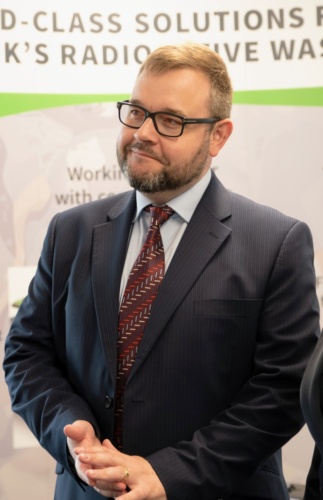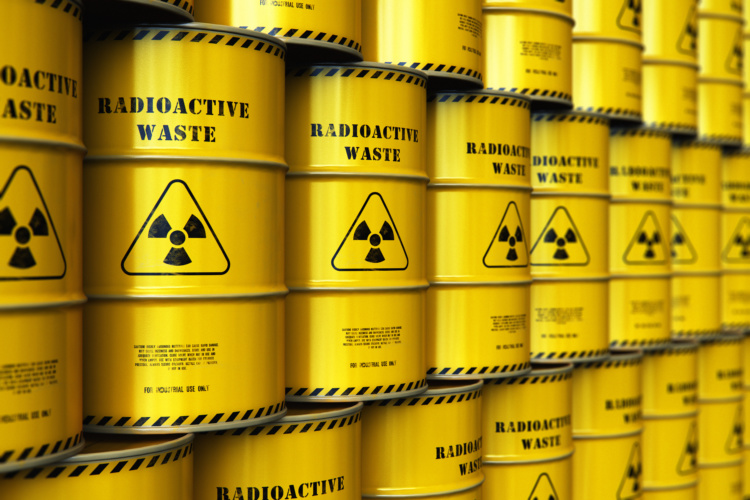Meet the experts
Bruce Cairns - chief policy advisor at Radioactive Waste Management (RWM), a public organisation established by government and responsible for planning and delivering geological disposal in the UK
Dr Adam Sims - radioactive waste consultant, Mott MacDonald
Dr Tim Marshall - nuclear safety inspector and ONR geological disposal lead
Neil Hyatt FRSC - Professor of Nuclear Materials Chemistry, The University of Sheffield
John Grimsich, Director of Sciences, Deep Isolation
Once built, a GDF will remain in place for several thousands of years. What are the main engineering challenges in building and operating a facility like this?
 BC: Constructing a nationally significant infrastructure project naturally comes with significant engineering challenges. We will have to design, construct and operate the facility to protect people and the environment for a very long time and until the waste naturally decays and is no longer harmful. Another challenge is that we will build and fill at the same time – meaning that there will be continued underground construction of the facility, during waste emplacement operations. This will require innovative engineering solutions to run these parallel activities safely. Consequently, plans for the construction and operation, which are dependent on location, site specific features, and the final waste inventory, will be developed over decades and integral to our approach.
BC: Constructing a nationally significant infrastructure project naturally comes with significant engineering challenges. We will have to design, construct and operate the facility to protect people and the environment for a very long time and until the waste naturally decays and is no longer harmful. Another challenge is that we will build and fill at the same time – meaning that there will be continued underground construction of the facility, during waste emplacement operations. This will require innovative engineering solutions to run these parallel activities safely. Consequently, plans for the construction and operation, which are dependent on location, site specific features, and the final waste inventory, will be developed over decades and integral to our approach.

 AS: This is a highly complex process which is reviewed throughout the GDF lifecycle to develop a site-specific concept that considers safety, security, community engagement, environmental impacts engineering feasibility, transport, cost and disposability of the current and expected waste inventories. The key challenges to engineering and operating a GDF is effective knowledge transfer, whilst working with large multi-disciplinary teams across a broad range of sectors, to allow for theoretical concepts to be envisaged and implemented under clearly defined timescales. Waste must be isolated safely at each stage, maximising the time between the breakdown of barriers and the final interaction with the environment and people post closure. Lessons learned from countries currently ahead of the UK in terms of implementation, such as Finland can be drawn on to allow a fuller understanding of challenges throughout the GDF lifecycle.
AS: This is a highly complex process which is reviewed throughout the GDF lifecycle to develop a site-specific concept that considers safety, security, community engagement, environmental impacts engineering feasibility, transport, cost and disposability of the current and expected waste inventories. The key challenges to engineering and operating a GDF is effective knowledge transfer, whilst working with large multi-disciplinary teams across a broad range of sectors, to allow for theoretical concepts to be envisaged and implemented under clearly defined timescales. Waste must be isolated safely at each stage, maximising the time between the breakdown of barriers and the final interaction with the environment and people post closure. Lessons learned from countries currently ahead of the UK in terms of implementation, such as Finland can be drawn on to allow a fuller understanding of challenges throughout the GDF lifecycle.
NH: The main challenge is in assuring the post-closure safety of the facility, which requires a detailed and evidenced safety case which has to predict the evolution of the facility over several hundred thousand years, considering processes on the scale of the atom, to the depth of the facility below the surface. In the UK context, we have been developing the basis of the safety case over the last decade, but it will need to be elaborated and tailored to the selected site.
TM: The main challenges foreseen during construction will be the management of conventional hazards associated with the construction and operation of the underground workings. Once constructed, ensuring suitable long-term stability, and associated asset management and maintenance of the underground structures are likely to be areas of key regulatory focus from an engineering perspective.
There is no guarantee that a GDF will be accepted in areas where it is proposed. What contingencies should be in place?
AS: RWM is implementing a Concept Selection Process to identify a number of potential sites to locate a future GDF and their approach to evaluating multiple potential sites gives some contingency to complete iterative sitting process. They will need to work with communities (locally and regionally), offering a successive programme of optioneering and optimisation to ensure the ‘best fit’ disposal concepts are developed and refined for each potential site and that preferable solution is carried forward. Presently, the main contingency would be to increase the volume of interim storage available within the UK infrastructure, holding accumulated wastes until and accepted GDF solution is agreed upon.
 TM: Higher Activity Radioactive Waste (HAW) is currently safely and securely stored at nuclear sites and will continue to accumulate, both from existing and new sources, where it will present an on-going risk requiring active management until a final disposal solution is delivered. ONR agrees that a safe permanent disposal route is needed to resolve this situation and supports government policy for long-term management of HAW through geological disposal.
TM: Higher Activity Radioactive Waste (HAW) is currently safely and securely stored at nuclear sites and will continue to accumulate, both from existing and new sources, where it will present an on-going risk requiring active management until a final disposal solution is delivered. ONR agrees that a safe permanent disposal route is needed to resolve this situation and supports government policy for long-term management of HAW through geological disposal.
NH: The contingency is continued surface storage, which is the current practice. Technically, it is feasible to repackage the waste every few decades and build new stores. However, this is effectively kicking the waste can down a never-ending road; it would be leaving the cost, risk and responsibility of managing and safely disposing of the waste to future generations who did not benefit from the energy generation. One potential option for siting a GDF could be just off-shore under the seabed, with surface facilities and the access point located on shore, which might, or might not, be considered less contentious.
Could the waste be exported, or could surface-level storage continue until other disposal methods are available, such as in Prism reactors?
BC: The import or export of radioactive waste is not allowed, except in very limited circumstances, so we must manage our own waste. Whilst current storage arrangements are safe and secure in the short-term, some of the waste will remain radioactive for many thousands of years. A permanent disposal solution is therefore needed and there are currently no viable long-term waste management options that remove the need for a UK GDF. Whilst some materials now in storage could theoretically be re-used in some way, most of our radioactive waste cannot, and re-using those materials will produce further waste to be disposed of.
Are there other feasible options other than a GDF?
AS: There are a number of alternative disposal options must be considered and should be kept under review throughout the GDF implementation stages ensuring a fully comprehensive decision is made. However, most of the alternative disposal options are either less feasible currently or have been largely discounted in favour of a GDF. Some of these are options such as deep-sea disposal, disposal at subduction zones, long term above ground storage, rock melting, deep well injection, disposal in ice-sheets and even disposal into out of space. Scotland currently favour Near Surface Disposal which mimics the concept of a GDF at less of a depth which would also be a favourable option and has pros and cons to it in comparison to a GDF. Near surface disposal for short lived intermediate level wastes are under further investigation in the UK. A consensus internationally found a GDF to be the preferred disposal method with most nuclear waste generating countries opting for this option for the safe disposal of heat generating radioactive wastes. Therefore, in the long-term the choice currently is between near surface disposal and geological disposal.
 NH: Deep isolation borehole technology is potentially suitable for a small fraction of the UK’s radioactive waste inventory such as spent nuclear fuel or high level vitrified waste, and there are some potential cost, safety and security advantages that could arise from application to these and other potential wastes. That said, the technology is still at an early stage of development and needs considerably more in the way of full-scale demonstration tests to build confidence in the approach. However, it will not change the need for a geological disposal facility to accept the remainder of the UK inventory of intermediate level waste.
NH: Deep isolation borehole technology is potentially suitable for a small fraction of the UK’s radioactive waste inventory such as spent nuclear fuel or high level vitrified waste, and there are some potential cost, safety and security advantages that could arise from application to these and other potential wastes. That said, the technology is still at an early stage of development and needs considerably more in the way of full-scale demonstration tests to build confidence in the approach. However, it will not change the need for a geological disposal facility to accept the remainder of the UK inventory of intermediate level waste.
Deep isolation with directional drilling
One company examining an alternative to GDF is Deep Isolation, a Berkeley, California headquartered enterprise whose directional drilling technology isolates nuclear waste deep underground. John Grimsich, Deep Isolation’s Director of Sciences, told The Engineer how it’s done.
There is international consensus that geologic disposal is the safest long-term solution to isolate intermediate and high-level nuclear waste from the biosphere. While we believe that a centralised, mined GDF can be successful and safe, Deep Isolation leverages advancements in directional drilling technology to access deeper geologic formations, providing another option to a traditional mined repository.
https://www.youtube.com/watch?time_continue=4&v=IQx5zFUUln0&feature=emb_logo
Deep Isolation recently completed a series of safety calculations for the disposal of pressurised water reactor fuel assemblies in a typical shale formation at 1km depth. The modelling and calculations support the concept that horizontal drill hole repositories provide a safe alternative to large mined repositories. Several disruptive scenarios were modelled, including repository disruption by earthquake faults and the unplanned release of radionuclides from emplacement canisters. In each case, the safety calculations and modelling indicate that the primary geologic barrier provides the necessary safe isolation from the biosphere.
In these carefully targeted rock formations, we create small diameter drill hole repositories, 1-3km in length, where multiple nuclear waste canisters are placed end-to-end in the horizontal section of the drill hole. The repositories remain within the confines of the identified host rock strata where they are isolated by the impermeable host rock and the overlying rock layers. A slight upward tilt of the repository away from the vertical access hole directs any buoyancy-driven migration of radionuclides toward the repository’s dead end. Drill hole repositories can be tailored to suit several waste forms, including reprocessed vitrified waste, unaltered PWR and BWR fuel assemblies and defence waste forms.
There are many advantages to horizontal drill hole repositories: Safety in depth; access to more geologic formations; flexibility in siting and repository design; modularity; minimal disturbance of the host rock; no humans underground; more rapid implementation; and, ultimately, more affordability. The greater reach of horizontal drill hole repositories and access to deeper rock strata make it possible for repositories to be located at or near nuclear power plants, minimising the need to transport high-level waste long distances. This may be particularly relevant in the siting of new nuclear power plants or next-generation nuclear power plants, where a self-contained disposal plan is desired. In addition, Deep Isolation’s community engagement program promotes establishing trust and a shared understanding of nuclear waste management. We work with all stakeholders and interested members of the public to create partnerships and build lasting relationships.
We believe there are several responsible options for the geologic disposal of high-level nuclear waste. Deep horizontal borehole repositories provide an excellent, modular and cost-effective adjunct to large scale centralised mined repositories.




Collaboration to address viable solutions for VAWG database
Interesting to see what the funders say too..."The Innovation Launchpad Network+, .... brings together leading universities, the Catapult Network and...